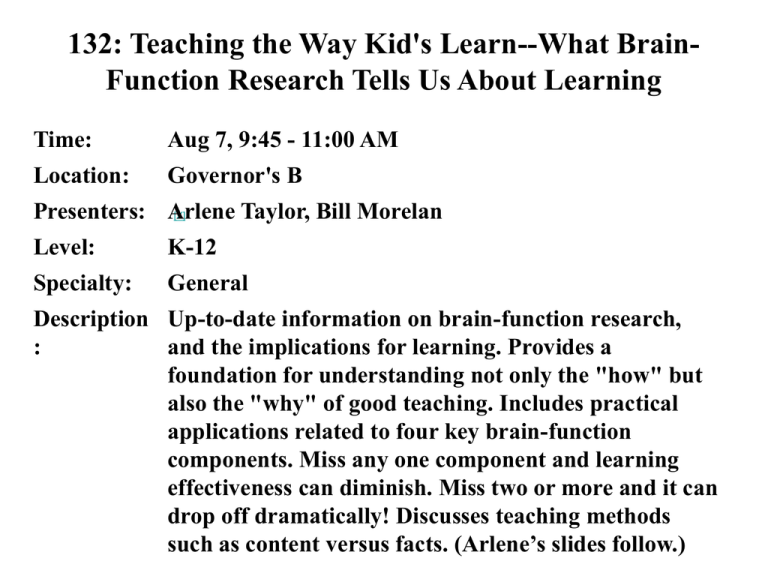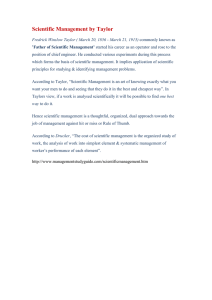132: Teaching the Way Kid's Learn--What Brain-
advertisement

132: Teaching the Way Kid's Learn--What BrainFunction Research Tells Us About Learning Time: Aug 7, 9:45 - 11:00 AM Location: Governor's B Presenters: Arlene Taylor, Bill Morelan [X] Level: K-12 Specialty: General Description Up-to-date information on brain-function research, : and the implications for learning. Provides a foundation for understanding not only the "how" but also the "why" of good teaching. Includes practical applications related to four key brain-function components. Miss any one component and learning effectiveness can diminish. Miss two or more and it can drop off dramatically! Discusses teaching methods such as content versus facts. (Arlene’s slides follow.) Teaching the Way Kid's Learn— What Brain-Function Research Tells Us About Learning Arlene Taylor PhD References: Selected Brain Facts www.arlenetaylor.org URL: http://www.arlenetaylor.org/selected_brain_facts/index.htm Learning can be Defined as: Arlene Taylor PhD Realizations Inc Skills or knowledge acquired through instruction, study, or experience The likelihood that skills or knowledge will be acquired -- the brain will transfer information from short-term to long-term memory -- is increased: • When the brain “gives a rip” (cares about the information or is interested in the topic) • When the information can be linked to something the brain already knows (metaphor, story, fact, label, process) Your Brain is as Unique Arlene Taylor PhD Realizations Inc As your thumbprint No two brains are ever identical in structure, function, or perception! • Give up any expectation of another brain perceiving anything exactly as yours perceives it—and vice versa • The way your brain functions largely determines the way in which you learn This section is one brain’s perception of the research The Human Brain Arlene Taylor PhD Realizations Inc Begins developing by about the 4th day after conception Weighs about 3 lbs in adulthood and contains 100 billion neurons and 900 billion neuroglia – give or take a few billion Houses the corpus callosum, a bridge of approximately 250 million nerve fibers that connects the two cerebral hemispheres Connects with all portions of the nervous system through a million miles of nerve fibers Learning by Design Requires Arlene Taylor PhD Realizations Inc A realization that every brain is different A commitment to identify (insofar as possible) and honor each person’s uniqueness An awareness of key components of brain function A willingness to brainstorm ways to address key brain-function components so learning is as easy as possible Fail to address one component and learning effectiveness can diminish Miss two or more and learning can drop off dramatically . . . Male-Female Continuum Arlene Taylor PhD Realizations Inc • Takes in 95% of the population • Checklists of psychological maleness or femaleness give two scores Empathizing Brain (equated more with female brain) Balanced Brain Systemizing = Empathizing Systemizing Brain (equated more with male brain) Some brains definitely lean toward systemizing, others lean toward empathizing, and some are 50-50 Some brains match their external housing while other’s don’t, and about 5% of brains don’t even fall on the continuum No wonder people are confused! Girl and Boy Brains Arlene Taylor PhD Realizations Inc • Brain is lighter and smaller • Brain is 10-15% heavier • 3 of 12 areas are larger (e.g., basal ganglia, language computation) • 9 of 12 areas larger (not certain how this impacts real-life functioning) • The left hemisphere matures earlier • Right hemisphere matures earlier • Larger corpus callosum: the brain typically tends to be more generalized and collegial • Smaller corpus callosum: brain tends to be more lateralized and instrumental (dyslexia, hyperactivity) • A gray matter peak occurs about age 11 • A gray matter peak occurs about age 12 Cross-Lag Development Arlene Taylor PhD Realizations Inc • Median development of a boy age 5 = development of a girl age 4 (approximate difference of 20%) • Scandinavian girls start first grade at age six, boys at age seven due to cross-lag in development • Girls are at a definite advantage in kindergarten and grade school due to more developed left hemisphere • May develop math and science anxiety in high school • Boys are at a distinct disadvantage in kindergarten and grade school due to more developed right hemisphere • Are at higher risk for dropping out before or during high school Girl/Boy Brains - Learning Arlene Taylor PhD Realizations Inc Girls: Boys: Better at long-term planning (may think ahead more about homework, exam deadlines, prom or special event) Better a short-term planning (may think more about recess and what is happening after school today) Better at handwriting and articulation Better at setting/achieving goals 100% of sounds are words 60% of sounds are words, 40% are non-language noises Tend to be more auditory and are often better readers (e.g., learn to read earlier and more easily) Tend to be more visual auditory skills may need to be honed to help reading. Bottom 10% in reading classes are boys Brains and Learning, Cont’d Arlene Taylor PhD Girl Brain Realizations Inc Boy Brain • Uses more energy second for second • Uses less energy second for second • Tends to function better in an environment that has low levels of distraction (e.g., IQ test scores were higher when room was quiet, may have difficulty concentrating with music playing in the background) • Tends to focus better in an environment where there is some distraction (e.g., IQ test scores were higher when there was some noise/distraction in the room, may concentrate easier / do homework better while listening to music) Brain Differences Impact Learning Arlene Taylor PhD Girl Brain Realizations Inc Boy Brain • Generally better able to sit quietly without fidgeting. Tend to be more auditory overall and better able to listen and pay attention to ideas. • Can find it difficult to sit quietly, listen, not fidget, and pay attention to ideas especially during auditory presentations (tend to be more visual). • Less likely to be diagnosed as hyperactive (e.g., only 5%-10% are girls) • More likely to be diagnosed hyperactive (e.g., 90%-95% are boys) • Less likely to be medicated for being too active physically • At higher risk for being medicated when activity levels don’t match those of a comparable girl Extroversion Ambiversion Introversion Arlene Taylor PhD Realizations Inc Labels refer to the brain’s focus – internal or external And little if anything to do with how much you like people Extreme Extroversion 15% Prefers variety, high intensity, and differing types of stimuli Ambiversion 70% A moderate blend of both types of characteristics E-I Continuum Extreme Introversion 15% Prefers less variety and intensity, and more depth) You can flex along the E-I Continuum in specific situations / environments to some degree and still function – long-term it will cost you in energy and can decrease your effectiveness Characteristics of Extreme E and I Arlene Taylor PhD Realizations Inc Style of energy recharging: (EE – by externals, EI – by internals) Approach to experiences: (EE – collecting; EI – pondering) Modification of incoming sensory data: (EE – miniaturized, EI – magnified) Size of metaphorical aperture: (EE – small, EI – large) Norepinephrine levels: (EE – low, EI – high) Blood flow pathways and fuel types are different: EE – Short, fast-acting, thru novelty/variety/senses. Fueled by dopamine. EI – Longer, complex, thru pondering/planning. Fueled by acetylcholine. Education Typically Rewards Arlene Taylor PhD Realizations Inc A portion of the ambiversion range Extreme Extroversion 15% Ambiversion J 70% Extreme Introversion 15% Individuals who do not match societal expectations often try very hard to function in the rewarded zone even when this requires prolonged adaption EE - Energy is drained in an under-stimulating environment (bored, restless, delinquent, fall asleep) EI - Energy is drained in an over-stimulating environment (tired, withdraw, get sick, become depressed) Typically Exhibited Characteristics Arlene Taylor PhD Realizations Inc Often form the basis for assumptions and labeling Extreme Extroverts: Extreme Introverts: • • • • • • • • • • • • • • Participative Outer directed Party person Debate/argue/compete Roughhouse/fight Often easily bored Perceived or labeled as: Noisy, restless, manic Undisciplined Non-cooperative ADD, ADHD Prefer to observe Inner directed Small groups Sit or stand alone Take a walk or nap May feel a “misfit” Perceived or labeled as: Quiet, loner Shy, timid, stuck-up Wallflower, reader Scaredy-cat Sensory Preference Arlene Taylor PhD Realizations Inc Sensory Preference: the type of sensory stimuli that registers most quickly in one’s brain Early in life human beings tend to use the senses almost equally during this period of extremely rapid learning By age 5 or 6 the brain begins to organize toward a sensory preference Sensory preference impacts how you prefer to absorb sensory data, the type of data you miss, the way you tend to communicate with other, and how you learn easily Estimates of Incidence Arlene Taylor PhD 20% Auditory Preference Realizations Inc 60% Visual Preference 20% Kinesthetic Preference N More females than males More males than females Equal males and females Problems can arise when the learner’s sensory preference is a mismatch with the teacher’s sensory preference . . . M-F Vision Style Differences Arlene Taylor PhD Realizations Inc Females tend to have a shortMales tend to have a longrange, wider, peripheral-vision range narrower, tunnel-vision style style (e.g., built-in binoculars) Females may find it easier to locate specific items in cupboards, drawers, and refrigerators as their vision takes in more of the immediate environment Males may find it easier to locate items that are a further away (e.g., signs, markers, hunting quarry) Male-Female Hearing Differences Arlene Taylor PhD Realizations Inc Females tend to hear better overall Males tend to have less acute hearing overall Eleven-year-old girls are distracted by noise levels that are approximately 10 times softer than the levels that boys find distracting. Hearing differences become more pronounced throughout life Success in reading is impacted by the ability of the brain to process sounds Practical Applications Arlene Taylor PhD Realizations Inc When communicating with females, minimize extraneous noise and distraction in the environment • Speak more softly if you have a loud voice When communicating with males, speak up and/or use a microphone • Minimize small-group learning situations (males are typically rewarded by their buddies for being disruptive, especially in small groups) Based on hearing differences, consider placing boys closer to teacher or moderator Thinking Preference Arlene Taylor PhD Realizations Inc Known as a brain lead, it refers to a brain’s specific biochemical advantage for processing information Based on PET Scan Studies, human brains are believed to possess an innate, stable, energy advantage in one of the natural cerebral divisions over the other three Brain lead is energy efficient and impacts: Ease of learning Level of competence Ability to sustain high performance Health and longevity Overall success Each Cerebral Division has a Purpose Arlene Taylor PhD Realizations Inc Functions enable humans to accomplish specific tasks Left Frontal Lobe Right Frontal Lobe To set and achieve goals, and make timely and objective decisions To anticipate and make changes, visualize, and innovate Left Posterior Lobes Right Posterior Lobes To provide and supply or maintain the services that are needed for sustaining life To build trust, harmony, connection, and peaceful foundations PET Scans Have Shown Arlene Taylor PhD Realizations Inc When performing non-preferred functions, the brain expends more energy and requires: • More oxygen, glucose, and micronutrition • A longer rest time to recover The difference in energy expended may be pennies on the dollar (monetary metaphor): • 1¢ per second versus $1 per second -- and that’s after the skills have been developed • Based on brain lead, the brain will tend to excel at some tasks energy-efficient expenditure), and procrastinate or struggle with others (energy-intensive expenditures) Orchestra Metaphor Arlene Taylor PhD Realizations Inc Think of the brain as an orchestra in which you are the soloist • You have the ability to play many different instruments • The sound at any given moment reflects the solo instrument • All instruments are equal but some are more equal than others in terms of the energy it takes for you to play • Your success and your fatigue at the end of a selection depends on the amount of time you played and whether or not the instrument was a good match with what your brain does energy efficiently Nothing in Life is Free Arlene Taylor PhD Realizations Inc You always give up something to get something – and the bottom-line unit of exchange is energy Knowing the way in which your brain functions most energy-efficiently can enable you to make pro-active choices about the types of tasks you undertake and the amount of time you devote to them Train yourself to become of aware of your relative energy expenditures and to ask: How much is this something going to cost me in energy? Do I want it badly enough to give up that much energy? Brain Energy Drain Arlene Taylor PhD Realizations Inc Can negatively impact your health, longevity, and long-term success Estimates are that human beings can shorten their lifespan from 14-25 years when they spend large amounts of time on tasks that are a mismatch with what their brain does energy-efficiently Human beings are more likely to be happy, healthy, and successful long term when there is a match between what the brain does energy-efficiently and a majority (e.g., 51%) of their life’s activities. Train up a Child in the Way . . . Arlene Taylor PhD Realizations Inc One purpose of education is to develop skills in all four divisions Some subjects will require higher levels of energy expenditure, other less Minimize brain drain by sandwiching tasks that require more energy between those that are energy efficient Reward EFFORT as well as OUTCOME For the long term, assist learners in selecting a career that is a match with their brain’s innate advantage – where the key tasks involve energy-efficient brain functions Learning by Design Requires Arlene Taylor PhD Realizations Inc An understanding of brain-function components that impact learning, including: Gender Brain differences Extroversion-Introversion ratio Sensory Preference Thinking Process Style Along with a willingness to brainstorm ways to address each component in practical application, and a commitment to identify (insofar as possible) and honor each unique brain Remember: Example is the most memorable of teachers! Speaker Information If you ask Arlene Taylor what she does in life that absolutely energizes her, she will likely reply, “I’m a brain-function specialist and I help people thrive!” She incorporates cuttingedge brain-function research into her empowering seminars, highlighting strategies that, when practically applied, can help people be more successfulby design. A recipient of the American Medal of Honor for Brain-Function Education (American Biographical Institute Inc, 2002), Taylor holds earned doctorates in Health and Human Services and in Clinical Pastoral Counseling. In 1989 the Loma Linda University Nursing Alumni Association selected Taylor as Alumna of the year. She has life membership in the National Registry of Who’s Who, 2000 edition. A member of the National Speakers Association, Taylor is listed with the Professional Speakers Bureau International. Access her web site (www.arlenetaylor.org) for descriptions of seminars, Taylor-on-the-Brain Bulletins, SynapSez newsletter, Selected Brain Facts, Frequently Asked Questions, lecture schedules, and more. Brain Bulletin Offer To receive the bimonthly Taylor-on-the-Brain Bulletin electronically at no charge, complete the following: Print first and last names ____________________________________________ __________________________________________________________________ Print E-mail address _______________________________________________ Tear off this portion and give it to Arlene Taylor or send the information via email to: thebrain@arlenetaylor.org


